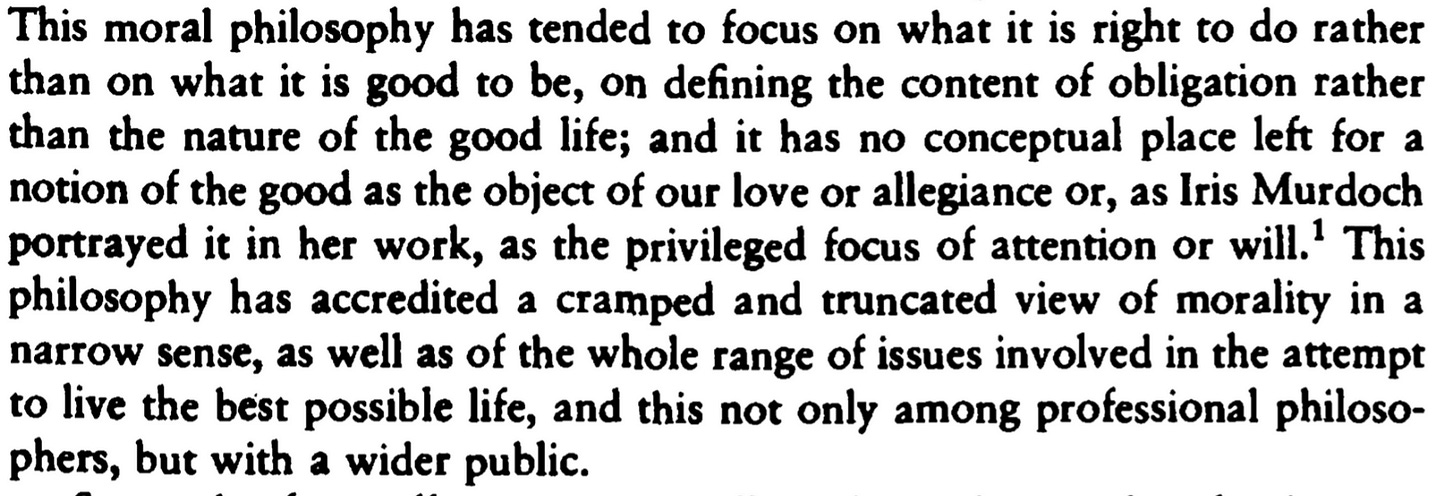Kyborg 18: SOS 2
Affordances
Let’s start with a cognitive framing on how to read Charles Taylor.
The heterodox psychologist J.J. Gibson has been an inspiration for many; Donald Norman, the author of “The Design of Everyday Things” and one of the minds behind Apple’s design revolution, is one of them. Norman says about Gibson:
Objects tell us how to interact with them. A chair tells us to sit (seems obvious), a car tells us to drive (less obvious) and a laptop tells us to type (doesn’t seem obvious at all). Gibson thought that affordances are there for the taking, but we might want to contextualize them, embedding affordances in Deshkaal. A laptop’s typability might be obvious to an inhabitant of a knowledge society but would offer no clues to one of Hammurabi’s minions.
Affordances have a history.
Selves as Interfaces
What works for objects might also work for selves. Our identities tell the world how to interact with us. A man in suit and tie invites one kind of interaction and a man in tie die invites another.
The self arises as a cluster of affordances that tells the world how to interact with us. But we can add an extra self-affordance: historical and other contingencies also tells the self how to interact with itself. Which is to say, the inner space, that realm of private consciousness that’s central to how the modern person experience themselves is an affordance.
You can see what I am trying to do here: as Taylor traces the outlines of the self, I will keep weaving a third cognitive thread into Taylor’s duo of analysis and history so that we surface the affordances that Kant uses to build his metaphysical system.
Here’s how Taylor frames his project:
Unlike an object which can be entirely characterized by what it is, a self demands an understanding of what it could be and what others like it are. The question “Who am I” can’t be answered without probing who I want to be and what’s preventing me from doing so.
Or perhaps that way of articulating the self is itself a modern framing - it’s possible that one of Hammurabi’s minions would have been satisfied with a self description in which what he ought to be is the same as what he is.
The self’s flourishing is inside the penumbra of the self, if not part of its definition. In any case, I think definitions are the wrong way to grasp the self. A better analogy is with polysemy. When I say:
The cow jumped over the gate
The plane flew over the city
The meanings of the preposition ‘over’ are related but distinct: in the case of the cow, the sentence marks the passage of the cow from one side of the gate to the other, while in the case of the plane, it marks the presence of the plane above the boundaries of the city. Natural language terms have shifting connotations based on context.
The self, in my view, is a worldly counterpart of concepts, i.e., a thing in the world that has shifting affordances based on who is querying whom. Taylor gives us a hint of this multi-faceted nature of the self:
Taylor seems himself as going against the grain of his peers, who treat morality as an autonomous domain independent of what it is to live a good life. That wall between morality and the good is itself a symptom of the separation of disciplines and sub-disciplines in the classification of intellectual life and the organization of departments.
Specialization, fragmentation and unification proceed apace in the modern world, both in the university and in our psyches. Taylor is a weaver. We can build upon his philosophical weaving by noticing that our social technologies (the law, academia etc) draw their resources from a cognitive realm in which morality, selfhood and flourishing are intertwined, though like in the outer world, the cognitive sources of selfhood etc might also be fragmented.
We will see how Taylor connects the self with the good and the good with the right tomorrow.







